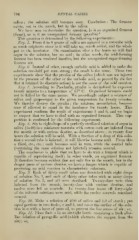Page 784 - My FlipBook
P. 784
794 DENTAL CARIES.
the solution still becomes sour. Conclusion : The ferment
saliva ;
exists, not in the starch, but in the saliva.
We have now to determine the question, Is it an organized ferment
(fungi), or is it an unorganized ferment (ptyalin)?
This question is determined by the following experiments :
Exp. 5. From 6 to 8 grams of saliva are agitated in a test-tube with
as much suli)huric ether as it will take up, starch added, and the whole
put in the incubator. On examination after a few hours Ave will find
sugar in the solution, but no acid ; in other words, the acid-forming
ferment has been rendered inactive, but the unorganized sugar-forming
ferment not.
Exp. 6. Instead of ether, enough carbolic acid is added to make the
solution one-half per cent, strong ; the result is the same. These two
experiments show that the ])tyalin of the saliva (which was not injured
by the presence of the ether or the carbolic acid, as proved by the fact
that it retained its diastatic action) is not the cause of the acid reaction.
Exp. 7. According to Paschutin, ptyalin is devitalized by exposure
twenty minutes to a temperature of 67° C Organized ferments could
not be killed by the same means. We accordingly subject a mixture of
saliva and grape-sugar to the given temperature for twenty minutes.
We thereby destroy the ptyalin ; the mixture, nevertheless, becomes
sour if allowed to stand in the incubator for twenty hours. This
experiment confirms the result of experiments 5 and 6, and we begin
to suspect that we have to deal with an organized ferment. This sup-
position is confirmed by the following experiment.
Exp. 8. Six to eight drops of a j)erfectly sterilized solution of sugar in
saliva (1-40) in a miniature test-tube with cotton cork are infected from
the mouth or with carious dentine, as described above ; in twenty-four
hours the solution will be acid. With a fraction of a drop of this solu-
tion a second tube is infected ; it will likewise become acid. From this
a third, etc., etc. ; each becomes acid in turn, while the control tube
(containing the same solution not infected) remains neutral.
The conclusion is plain that we have to do with a ferment M'hich is
capable of reproducing itself; in other words, an organized ferment.
It therefore becomes evident that not only free in the mouth, but in the
deeper parts of carious dentine, we have a fungus which is capable of
producing an acid reaction in characteristic substrata.
Exp. 9. Each of thirty small tubes was furnished with eight drops
of solution No. 1, and each of thirty other tubes with as many drops
of solution No. 3, and all were sterilized. Twenty-four were then
infected from the mouth, twenty-four with carious dentine, and
twelve were left as controls. In twenty-four hours all forty-eight
of the infected solutions were acid, while the twelve controls remained
neutral.
Exp. 10. Make a solution of 40.0 of saliva and 1.0 of starch; ])ut
equal portions in two fiasks, a and b, and cover the surface of the solu-
tion in a with a layer of pure oil, to prevent the free access of air ; or,
Exp. 11. Place flask a in an air-tight bottle containing a fresh alka-
line solution of pyrogallic acid (which abstracts the oxygen from the
air) ; or,


